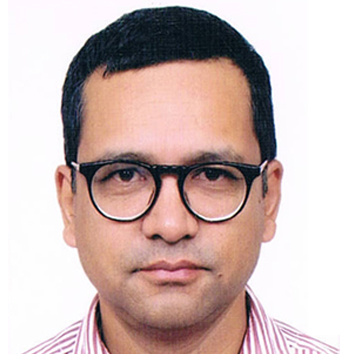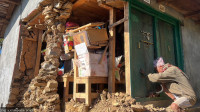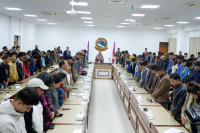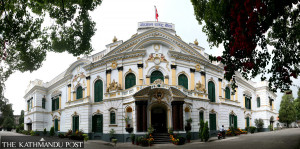Columns
Teaching history as an open debate
Argument-focused history is the best way to teach history to students in Nepal.
Pratyoush Onta
After I was admitted to St Xavier’s School in Jawalakhel—now celebrating its 75th year—in January 1972, I must have spent the minpachas of that winter looking forward to attending the school with its impressive football fields and big buildings. Classes for the year 1972 were supposed to begin on February 1. However, on the early morning of January 31, King Mahendra (1920-1972) passed away in Bharatpur. He had ascended the throne in March 1955. I knew little about Mahendra at that stage of my life.
I would, of course, read a lot about Mahendra in the later grades in school. I would do so not only in the Nepali textbook that had the title Mahendramala but in virtually all the other subjects apart from science and math. Most of the writings in my textbooks were hagiographic. It was only much later, when I underwent academic training to be a historian, that I got the opportunity to read the various works of different writers about the “real” King Mahendra.
Villain versus hero
Following several years of political experimentation, Mahendra promulgated a new constitution on February 12, 1959, arranging for a bicameral parliament under a very strong monarchy. The long-promised national elections were finally held between February and April 1959. The Nepali Congress won a majority of seats in the House of Representatives, and its leader, BP Koirala, became the first elected prime minister of Nepal in late May 1959. As the Koirala government enacted progressive reforms, the ambitious monarch inside Mahendra did not want to share political power and limelight with Koirala.
Instead, Mahendra wanted to exercise absolute power. In December 1960, he disbanded the parliament and banned the political parties. He arrested Koirala and many other political leaders and put them in jail for many years. Mahendra accused them of exercising power to fulfil personal and party-selfish goals. He also said they were responsible for the rise of corruption and an environment in which national unity was threatened by anti-national elements. After the coup, Mahendra consolidated power in his own hands and made sure that his hold over Nepal was absolute. Hence, King Mahendra was a villain who had nipped the democratic experiment in the bud. This, in broad strokes, is the story rendered by writers who are not supporters of absolute monarchy. This version, of course, did not find any space in the Mahendramalas I read or in the textbooks read by two subsequent generations of school-going Nepalis.
There was, of course, another narrative about Mahendra doing the rounds. Two years after taking absolute control, in December 1962, he officially promulgated a new constitution designed to execute his suitable-to-the-soil Partyless Panchayat System. He executed various development projects with the aim of achieving, within 10-20 years, the level of progress attained by other nations in a century. The most famous of these development projects was the East-West highway commissioned in 1962. He also rapidly expanded Nepal’s diplomatic connections to many other countries in the world during the height of the Cold War. He also planned many projects of cultural unification. Among the two that were most influential included the programming of Radio Nepal and the nationalisation of the school curricula in the country under the rubric of the New Education System Plan (NESP) announced in 1971. Mahendra, of course, did not live long enough to see the effects of the NESP, which continues to influence much of Nepal’s political and public culture. For these and other reasons, many writers of the monarchist camp consider him a hero.
Of course, on January 31, 1972, I did not know both of these perspectives on King Mahendra. As a child, I knew that the all-powerful king of my country had just died unexpectedly. And it had wrecked the plan for my first day of school at St Xavier’s. Almost 54 years after Mahendra’s death, these competing narratives are actively co-present in the Nepali public sphere. If anything, both of these narratives have become even more robust in the post-Panchayat era.
Debate as pedagogy
In her excellent introductory book to history as an academic discipline, Thinking about History (2017; Nepal reprint edition 2021), the American historian Sarah Maza suggests that “in order for the past to serve its best purpose we must not freeze it in place, we must argue about it.” In agreement with her, I would suggest that argument-focused history is the best way to teach history to both school and college students in Nepal. This kind of pedagogical re-imagining of history is hardly an original idea on the global stage. But, unfortunately, it has not received the appropriate attention it deserves in our country.
The centralised bureaucratic mechanism through which our public school and college curricula are determined is partly to blame for this state of affairs. Market forces, which have falsely rendered disciplines such as history as “useless”, are also at fault. But the largest blame should go to Nepali historians for failing to be innovative about argument-focused history in the pedagogical aspects of our discipline. We have not invested our intellect and time to this matter, nor created the appropriate age-relevant resources that could be used in our classrooms.
Apart from the competing narratives discussed above as an example of what I mean, many other examples could be used in a teaching context. The middle-age historian in me first thinks of printed books as the most necessary resources to be created for use in our classrooms. For school-age students, such books must feature many images and minimal text. For college students, imaginatively edited thematic or era-specific volumes with articles that provide competing narratives as arguments would be handy. However, unlike Nepali sociologists and anthropologists, Nepali historians have been largely amiss when it comes to producing such edited collections.
For digital-native students, other types of pedagogical resources will also be needed. These can come in the form of audiobooks, animated stories, visual podcasts, recorded interviews with historians, documentaries and other similar media. No matter what kind of resources are used, classrooms will have to be led by teachers who are open to competing narratives and not ones who have drunk deeply from the monochromatic well of the NESP. Visual recordings of good and innovative teaching should be uploaded online.
Students should develop the habit of delving into all sides of a debate, and college students should get involved in reading relevant primary sources. Creation of such teaching resources and a conducive classroom environment for learning will require additional financial investments from the public, private and non-governmental sectors.
But is anyone listening?




 13.12°C Kathmandu
13.12°C Kathmandu















